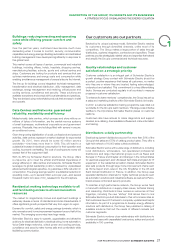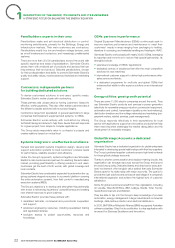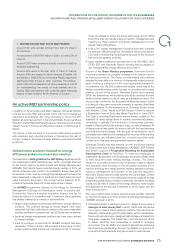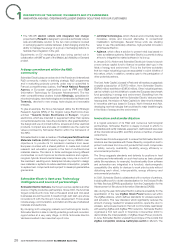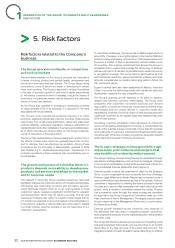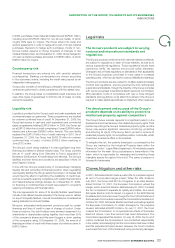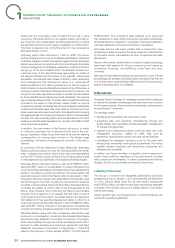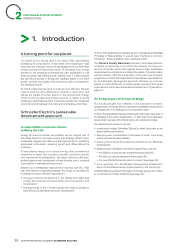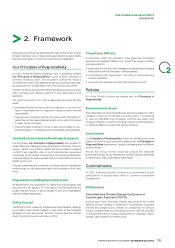APC 2009 Annual Report Download - page 33
Download and view the complete annual report
Please find page 33 of the 2009 APC annual report below. You can navigate through the pages in the report by either clicking on the pages listed below, or by using the keyword search tool below to find specific information within the annual report.
2009 REGISTRATION DOCUMENT SCHNEIDER ELECTRIC 31
DESCRIPTION OFTHEGROUP, ITSMARKETS ANDITSBUSINESSES
1
RISK FACTORS
the business was acquired to strengthen or extend the Group’s
existing line up or penetrate a new segment. All told, there are fi ve
scenarios ranging from total integration to separate organisation .
Depending on the strategic objective, a matrix is drawn up showing
the required level of integration for each of the newly-acquired
business’s core functions, i.e., front offi ce (sales force and brand),
back offi ce, R&D, corporate functions and management reporting.
An integration plan is drawn up for each acquisition and submitted
to the A cquisitions C ommittee for approval. The plan is implemented
by an integration manager who reports to a Steering Committee
that initially meets at monthly intervals and then on a quarterly basis.
The unit that presents the external growth project is accountable
to Group Senior Management for meeting clearly defi ned business
plan targets covering the performance of the new business and
expected synergies with existing businesses. Actual performance is
measured against business plan targets during quarterly business
reviews and, for the largest acquisitions, by the Management Board
and Supervisory Board.
Value in use is determined by discounting estimated future cash fl ows
that will be generated by the tested assets, generally over a period of
not more than fi ve years. Estimated future cash fl ows are based on
management’s economic assumptions and operating forecasts. The
discount rate corresponds to Schneider Electric’s weighted average
cost of capital (WACC) at the measurement date plus a risk premium
depending on the region in question. The Group’s WACC stood at
8.1% at December 31, 2009 compared with 8.2% at December
31, 2008. The perpetuity growth rate was 2% in 2009, unchanged
from the previous year.
Goodwill is allocated to a Cash Generating Unit (CGU) when initially
recognised . The allocation is made on the basis used to track the
performance of Group operations and to assess the benefi ts derived
from the synergies of the business combination. Impairment tests
are conducted by the CGUs, which at Schneider Electric correspond
to the Operating Divisions (Europe, North America, International and
Asia-Pacifi c) and Business Units (Critical Power & Cooling Services
(CPCS), Building Automation (BA) and Customised Sensors &
Technologies (CST). Details on asset impairment are provided in
Note1.11 to the consolidated fi nancial statements (see Chapter5).
If the recoverable amount of an asset or CGU is lower than its
carrying amount, an impairment loss is recognised . To the extent
possible, impairment losses on CGUs comprising goodwill are
recorded as a deduction from goodwill.
The Group is dependent upon hiring and
retaining highly qualified management and
technical personnel
Competition for highly qualifi ed management and technical personnel
is intense in the Group’s industry. Future success depends in part on
the Group’s ability to hire, assimilate and retain engineers and other
qualifi ed personnel.
The Group’s human resources strategy is designed to create
a motivating working environment. Specific policies have been
developed covering international mobility, career development,
training and compensation. The Group’s expatriates help prepare the
future of its business, build local teams and assemble the necessary
skill-sets in targeted regions. The Group places considerable
emphasis on training to deepen its skills base and retain employees.
Industrial and environmental risks
The Group may be the subject of product
liability claims and other adverse effects due
to defective products, design faults or harm
caused to persons and property
Despite its testing and quality procedures, the Group’s products
might not operate properly or might contain design faults or defects.
These design faults and defects could result in product liability
claims, loss of revenue, warranty claims, litigation, a fall-off in demand
or harm to Schneider Electric’s reputation for safety and quality. To
prevent or limit these risks, the Group recalls products if there are any
doubts about a component, even if the defect is random and does
not pose a safety risk. In 2009, the Group launched a broad recall
campaign concerning a range of low voltage capacitors produced
between 2004 and 2008. The campaign will be carried out for the
most part in 2010.
Some of the expenses incurred by Schneider Electric in the context
of its product recall are covered by the liability insurance programme
described in the insurance paragraph below .
The Group recorded a provision for product risk in an amount
of EUR 264million in the fi nancial statements for the year ended
December 31, 2009 (see Note23 to the consolidated fi nancial
statements).
The Group’s plants and products are subject to
environmental regulations
The Group’s plants and products are subject to extensive and
increasingly stringent environmental laws and regulations in all of
its host countries.
To limit risks related to the environment in general, the Group is
involved in a process to continuously improve the environmental
performance of its plants and products. In 1992, the Group published
a formal environmental policy designed to improve manufacturing
processes, promote eco-design and integrate customer concerns in
the area of environmental protection. This policy also aims to identify,
assess and prevent environmental risks, in order to guarantee full
compliance with all environmental laws and regulations applicable
to the Group’s businesses. Environmental provisions are booked
when the risks can be reliably measured or it is probable that clean-
up work will be performed and the related cost can be reasonably
estimated. Provisions for environmental risks totalled EUR 44 million
for the year ended December 31, 2009. No estimate is made of the
potential cost of unidentifi ed environmental risks. The Group expects
its spending on environmental compliance programmes to increase
as a result of changes to existing environmental regulations and the
introduction of new regulations.
There can be no guarantee that the Group will not be required to
pay signifi cant fi nes or compensation as a result of past, current or
future breaches of environmental laws and regulations by companies
that are currently or were previously members of the Group. This
exposure exists even if the Group is not responsible for the breaches,
in cases where they were committed in the past by companies or
businesses that were not part of the Group at the time.
The Group may be exposed to the risk of claims for breaches of
environmental laws and regulations. Such claims could adversely
affect the Group’s fi nancial position and reputation, despite the efforts
and investments made to comply at all times with all applicable
environmental laws and regulations.


